The Chemistry Shack
Harmless

Posts: 29
Registered: 11-6-2015
Location: Science
Member Is Offline
Mood: All the moods
|
|
Purification of 70% Ethyl Rubbing Alcohol--An Illustrated Guide
Purification of 70% Ethyl Rubbing Alcohol
**I have a video on my youtube channel that covers this process in more detail: https://www.youtube.com/watch?v=HOkKawJRZsk
Abstract
70% ethyl rubbing alcohol can be purchased from pharmacies for about $6 per L, providing a cheap source of OTC ethanol. An important note is that it
is much cheaper to purchase absolute ethanol online than to make it using this method. But nonetheless, this purification procedure is a fun exercise
and does provide an easy source of ethanol. The 70% ethanol was contaminated with water, acetone, methyl isobutyl ketone, and denatonium benzoate, so
it was the goal of this experiment to remove these contaminants from the ethanol. After carrying out 4 purification steps (outlined below), 1 L of
~94% ethanol was obtained from 4 bottles, each containing 473 mL of 70% solution, giving a 66% yield.
Theory
The theory behind the purification process was to carry out a series of distillations, each one removing a specific contaminant.
The 1st distillation will concentrate the ethanol to 85%, as well as leaving behind the higher-boiling denatonium benzoate and MIBK in the boiling
flask. Acetone will be carried over with the ethanol as well.
The 2nd step will be to dry the product using a drying agent.
The 3rd step will be to fractionally distill the mixture to remove the acetone.
Finally, the last step will be to distill the ethanol to separate it from any drying agent that may have dissolved in it.
Method
Step 1: Simple Distillation
473 mL Ethanol solution (1 bottle) was charged into a 1 L RBF and it was heated until a distillate came over at 78o C. The flask was insulated in
Aluminum foil to keep the heat in and speed up distillation.
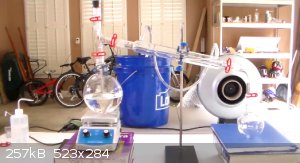
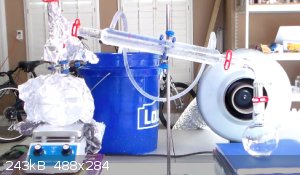
After the first 200 mL of ~85% ethanol came over, I switched to a different setup. I attached a Claisen adaptor to the boiling flask and attached an
addition funnel to the side-neck of the adaptor, while connecting the other neck to the 105o distillation adaptor (I didn’t take 1 photo of the
whole apparatus, but you can see how it looks in the video).
The funnel was repeatedly topped off with ethanol solution and slowly dripped into the flask. This allowed for continuous distillation instead of
several smaller distillations.
At the end of this distillation I was left with 1.5 L of about 90% ethanol (determined by measuring density). 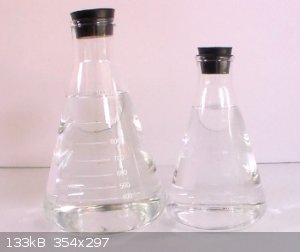
Step 2: Drying the Ethanol
The ethanol was dried using magnesium sulfate, but several other desiccants could be used (such as sodium sulfate, potassium carbonate, molecular
sieves). MgSO4 was added until it no longer clumped, indicating that all water had been absorbed. It was then shaken, allowed to settle, and vacuum
filtered off.
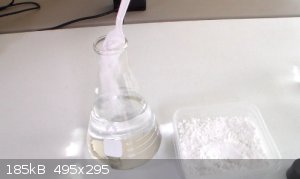
Adding MgSO4
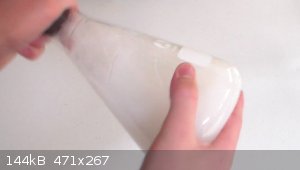
Shaking
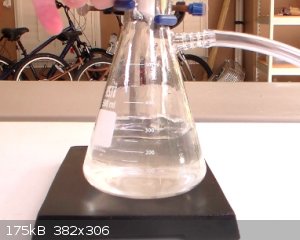
Filtering off the MgSO4
Step 3: Fractional Distillation *OPTIONAL*
In order to separate the acetone from the ethanol, a fractional distillation must be carried out, due to the close boiling points of the two
solvents.
A fractionating still is set up, using steel wool to pack the fractionating column.
Because my ethanol only had a small percent of acetone contamination and because acetone contamination was acceptable for my purposes, I did not
fractionally distill all of the ethanol. I only distilled 200 mL for demonstration purposes.
The acetone distillate was collected at a slow rate at 56o C. Once the temperature rose above 56 C, the distillation was stopped and the acetone
distillate was discarded. The liquid that remains in the flask should be dry, acetone-free ethanol.
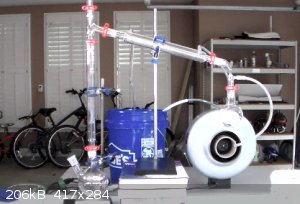
Fractional distillation setup
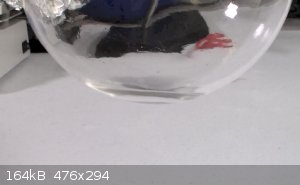
Acetone distillate (notice the small volume, indicating a very low concentration of acetone contamination)
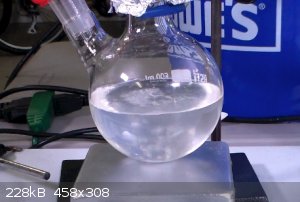
Ethanol remaining in distillation flask
Step 4: Simple Distillation to Recover the Ethanol
Regardless of whether or not you did step 3, your ethanol will have a small amount of magnesium sulfate dissolved into it, so a simple distillation is
needed to remove this contaminant.
NOTE: This is not necessary if you use molecular sieves. If you use molecular sieves to dry your ethanol, only a filtration is needed to remove them.
Results
After this purification procedure, 1.0 L of 94% ethanol was obtained. It should be noted that using MgSO4 to dry ethanol will typically give ethanol
of 98% or higher. However, I waited several days after drying to distill the ethanol, so this likely gave the ethanol time to absorb water from the
air (as anhydrous ethanol naturally wants to absorb water and dilute itself to the 96.5% azeotrope.
Given that the theoretical yield was 1.32 L of anhydrous ethanol, this corresponds to a 66% yield.
Given that the 4 bottles cost about $12, this procedure yielded ethanol at a cost of $12 per Liter*. While this is the least expensive source of
absolute ethanol I am aware of, it is a very lengthy process for a cheap solvent, and I personally would prefer to purchase absolute ethanol online,
even though it will be more expensive.
The presence of water in the ethanol can also be demonstrated by adding a small scoop of white copper sulfate to 2 mL of the ethanol in a test tube
and shaking it up.
The copper sulfate turns a light blue color, indicating that water is present in the ethanol.
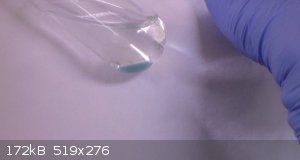
CuSO4 turning blue, indicating the presence of water
*This is actually a misleading value. Given that I collected 94% ethanol with a density of 0.807 kg/L, it would be more correct to say that this
process gave 0.76 kg ethanol for $12, or $16 per kg of Ethanol.
Conclusion
94% ethanol at a cost of $12 per L was obtained from 4 bottles (1892 mL in total) in a 66% yield based on the starting 70% solutions. This gave
relatively cheap ethanol, but is a lengthy process and it is up to the discretion of the experimenter to decide to use this procedure or to purchase
absolute ethanol directly.
Lab Techniques
In addition to providing a source of ethanol, this procedure is a great way to practice common laboratory techniques such as:
• Simple distillation
• Fractional distillation
• Use of drying agents
• Vacuum filtration
• Testing for water using CuSO4
• Using a hydrometer to measure density
• Interpreting a density vs. concentration graph
[Edited on 15-8-2015 by The Chemistry Shack]
[Edited on 15-8-2015 by The Chemistry Shack]
[Edited on 15-8-2015 by The Chemistry Shack]
[Edited on 16-8-2015 by The Chemistry Shack]
[Edited on 16-8-2015 by The Chemistry Shack]
[Edited on 16-8-2015 by The Chemistry Shack]
|
|
|
gdflp
Super Moderator
      
Posts: 1320
Registered: 14-2-2014
Location: NY, USA
Member Is Offline
Mood: Staring at code
|
|
Overall, not bad. However, I have some issues with this procedure. First of all, as you are purifying the ethanol and not synthesizing or preparing
it, there is no yield. Instead, this should be listed as a percent recovery.
Secondly, I believe that the water content in your ethanol may be partially due to a lack of drying agent. Based on your previous posts regarding the
preparation of anhydrous magnesium sulfate, I doubt it is truly anhydrous, likely the monohydrate. To get truly anhydrous magnesium sulfate, it
should be heated to 350°C under vacuum for several hours. Roughly, based on 10%(w/w)? (w/v)? (v/v)? water content after the first distillation, you
would need at least 192g of magnesium sulfate to fully dry it, did you use this much? You should also mention calcium oxide as a drying agent, as
this is the classical drying agent for drying near azeotropic ethanol. On a different notes, molecular sieves can also be quite dusty depending on
the sieves, similar to magnesium sulfate, so a vacuum filtration may not fully remove them and leave cloudy ethanol(It still should be fine for use in
reactions though).
I also have doubts on whether or not the acetone can be truly quantitatively removed with a (seemingly unpacked) column. Refluxing the ethanol for
several hours over sodium hydroxide would serve to both dry the ethanol and remove acetone via an aldol condensation forming higher boiling polymers
as well as a reaction of the enol and ethanol forming 2,2-diethoxypropane.
Also, any idea why the recovery is so low? I would expect recoveries of at least 80-85%+ if the ethanol was only distilled twice.
Finally distillation of ethanol is illegal without proper licensing and permits in most parts of the world, this should be noted in your procedure for
those unaware.
|
|
|
The Chemistry Shack
Harmless

Posts: 29
Registered: 11-6-2015
Location: Science
Member Is Offline
Mood: All the moods
|
|
Quote: Originally posted by gdflp  | Overall, not bad. However, I have some issues with this procedure. First of all, as you are purifying the ethanol and not synthesizing or preparing
it, there is no yield. Instead, this should be listed as a percent recovery.
|
Thank you for this. I will edit it in the original post.
Quote: Originally posted by gdflp  |
Secondly, I believe that the water content in your ethanol may be partially due to a lack of drying agent. Based on your previous posts regarding the
preparation of anhydrous magnesium sulfate, I doubt it is truly anhydrous, likely the monohydrate. To get truly anhydrous magnesium sulfate, it
should be heated to 350°C under vacuum for several hours. Roughly, based on 10%(w/w)? (w/v)? (v/v)? water content after the first distillation, you
would need at least 192g of magnesium sulfate to fully dry it, did you use this much? You should also mention calcium oxide as a drying agent, as
this is the classical drying agent for drying near azeotropic ethanol. On a different notes, molecular sieves can also be quite dusty depending on
the sieves, similar to magnesium sulfate, so a vacuum filtration may not fully remove them and leave cloudy ethanol(It still should be fine for use in
reactions though).
|
The weight percent was in w/w%. I dehydrated the MgSO4 in an oven at 400 C for 2 hours (although no vacuum was applied, so it might be the
monohydrate).
I definitely did not use 192 g. I added MgSO4 until it stopped clumping, and then filtered. I also dried it again using fresh MgSO4 (it clumped up
quite a bit this time as well).
Quote: Originally posted by gdflp  |
I also have doubts on whether or not the acetone can be truly quantitatively removed with a (seemingly unpacked) column. Refluxing the ethanol for
several hours over sodium hydroxide would serve to both dry the ethanol and remove acetone via an aldol condensation forming higher boiling polymers
as well as a reaction of the enol and ethanol forming 2,2-diethoxypropane.
|
I forgot to mention this for some reason, but (I know it's hard to tell), the condenser was packed with fine grade steel wool.
I distilled the acetone off until the temp started rising above 56 C, so I'm fairly certain I removed all of the acetone.
Quote: Originally posted by gdflp  |
Also, any idea why the recovery is so low? I would expect recoveries of at least 80-85%+ if the ethanol was only distilled twice.
|
This was my first large-scale distillation experiment, so I'm failry certain the low recover was due entirely to lack of experience.
[Edited on 17-8-2015 by The Chemistry Shack]
|
|
|
|